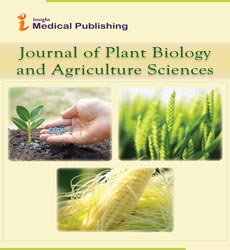Control of Various Plant Qualities
Mats Tysklind*
Department of Chemistry, Umeå University, SE-901 87 Umeå, Sweden
- *Corresponding Author:
- Mats Tysklind
Department of Chemistry, Umeå University, SE-901 87 Umeå, Sweden
E-mail: mats.tysklind@umu.se
Received date: 02 August, 2021; Accepted date: 16 August, 2021; Published date: 23 August, 2021.
Citation:Dr. Tysklind M (2021) Control of Various Plant Qualities. J Plant Bio Agric Sci Vol.5 No.6:101
Introduction
Plant hereditary qualities is the investigation of qualities,hereditary variety, and heredity explicitly in plants. It is by andlarge viewed as an area of science and organic science, yetconverges oftentimes with numerous other life sciences and isunequivocally connected with the investigation of dataframeworks. Plant hereditary qualities is comparative fromvarious perspectives to creature hereditary qualities howevercontrasts in a couple of key regions. The pioneer of hereditaryqualities was Gregor Mendel, a late nineteenth centuryresearcher and Augustinian monk. Mendel examined "qualitylegacy", designs in the manner in which attributes are given overfrom guardians to posterity. He saw that living beings (mostbroadly pea plants) acquire attributes via discrete "units oflegacy". This term, actually utilized today, is a to some degreequestionable meaning of what is alluded to as a quality. Quite abit of Mendel's work with plants actually shapes the reason forcurrent plant hereditary qualities. Plants, similar to every singleknown life form, use DNA to pass on their qualities. Creaturehereditary qualities frequently centers around parentage andancestry, yet this can in some cases be troublesome in planthereditary qualities because of the way that plants can, incontrast to most creatures, act naturally ripe. Speciation can besimpler in many plants because of extraordinary hereditarycapacities, for example, being very much adjusted to polyploidy.Plants are interesting in that they can deliver energy-thick sugarsby means of photosynthesis, a cycle which is accomplished byutilization of chloroplasts. Chloroplasts, similar to the cursorilycomparable mitochondria, have their own DNA. Chloroplasts inthis way give an extra supply to qualities and hereditary variety,and an additional layer of hereditary intricacy not found increatures. Deoxyribonucleic corrosive (DNA) is a nucleiccorrosive that contains the hereditary directionsutilized in theturn of events and working of all known living beings and someinfections. The principle job of DNA atoms is the drawn outcapacity of data. DNA is frequently contrasted with a bunch ofoutlines or a formula, or a code, since it contains the directionsexpected to build different parts of cells, like proteins and RNAatoms. The DNA sections that convey this hereditary data arecalled qualities, and their area inside the genome are alluded toas hereditary loci, yet other DNA groupings have primarypurposes, or are associated with managing the utilization of thishereditary data. Geneticists, including plant geneticists,utilizethis succession of DNA for their potentialbenefit to more readilydiscover and comprehend the job of various qualities inside agiven genome. Through exploration and plant rearing, control ofvarious plant qualities and loci encoded by the DNA grouping ofthe plant chromosomes by different strategies should bepossible to deliver unique or wanted genotypes that outcome invarious or wanted aggregates. Plants, similar to any remainingknown living life forms, pass on their qualitiesutilizing DNA.Plants anyway are exceptional from other living life forms in theway that they have Chloroplasts. Like mitochondria, chloroplastshave their own DNA. Like animals, plants experience substantialchanges consistently, however these transformations can add tothe germ line effortlessly, since blossoms create at the closuresof branches made out of physical cells. Individuals have knownabout this for quite a long time, and freak branches aredesignated "sports". In the event that the natural product on thegame is monetarily alluring, another cultivar might be acquired.Some plant species are equipped for self-preparation, and someare almost solely self-manures. This implies that a plant can beboth mother and father to its posterity, an uncommon event increatures. Researchers and specialists endeavoring to makecrosses between various plants should take exceptionalmeasures to keep the plants from self-preparing. In plantrearing, individuals make cross breeds between plant species forfinancial and stylish reasons. For instance, the yield of Corn hasexpanded almost five-overlap in the previous century due tosome degree to the revelation and expansion of half breed cornassortments. Plant hereditary qualities can be utilized to foreseewhich mix of plants might deliver a plant with Hybrid power, oralternately numerous disclosures in Plant hereditary qualitieshave come from examining the impacts of hybridization.
Open Access Journals
- Aquaculture & Veterinary Science
- Chemistry & Chemical Sciences
- Clinical Sciences
- Engineering
- General Science
- Genetics & Molecular Biology
- Health Care & Nursing
- Immunology & Microbiology
- Materials Science
- Mathematics & Physics
- Medical Sciences
- Neurology & Psychiatry
- Oncology & Cancer Science
- Pharmaceutical Sciences
